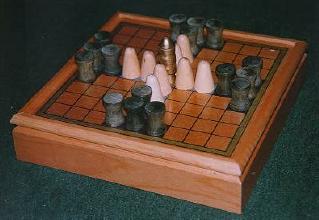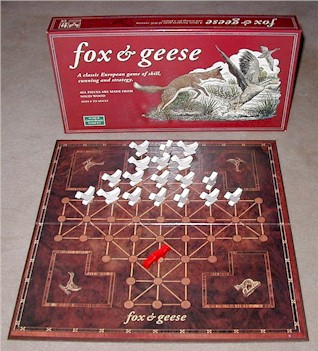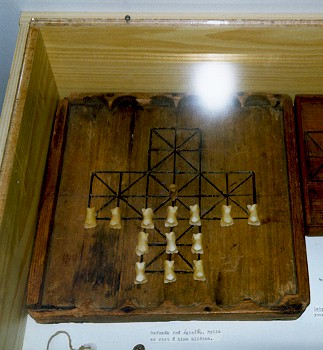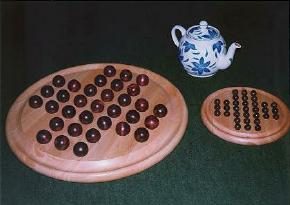The Tafl Family
History
Games of the Tafl family are distinguished by the unequal size of the opposing
forces. The objective is usually for the force of fewer numbers to take all
the members of the larger forces whose aim is generally to stop them doing so.
A fragment of a gaming board of 18 x 18 squares, found in Wimose, Fyn, Denmark
dated prior to AD400 is the first evidence of a game called Tafl, which also
regularly appears in the early Icelandic sagas.
 Tafl
apparently developed into Hnefatafl (which literally translates as 'Kings Table'),
which was played by the Saxons as well as other Northern Europeans on the same
size board and which is mentioned in Icelandic sagas from the beginning of the
fourteenth century. The Vikings took the game with them on their forages which
helped it to spread far and wide. A Latin text written during the reign of King
Athelstan (AD 925-40) describes the Saxon form of Hnefatafl which was played
in England at the time. It was most popular in Northern Europe during the dark
ages until Chess started to take over during the 11th Century and the last references
to it being played are in Wales in 1587 and in Lappland in 1723. It isn't known
exactly how either Tafl or Hnefatafl were played.
Tafl
apparently developed into Hnefatafl (which literally translates as 'Kings Table'),
which was played by the Saxons as well as other Northern Europeans on the same
size board and which is mentioned in Icelandic sagas from the beginning of the
fourteenth century. The Vikings took the game with them on their forages which
helped it to spread far and wide. A Latin text written during the reign of King
Athelstan (AD 925-40) describes the Saxon form of Hnefatafl which was played
in England at the time. It was most popular in Northern Europe during the dark
ages until Chess started to take over during the 11th Century and the last references
to it being played are in Wales in 1587 and in Lappland in 1723. It isn't known
exactly how either Tafl or Hnefatafl were played.
Evidence shows that the game of Tablut, described by a
traveller called Linnaeus during his trip to Finland in 1732, is likely to have
been very similar to Hnefatafl. It is played on a 9 x 9 board with one player
controlling a King who starts in the centre and who is supported by eight blonde
Swedes versus the other player who moves sixteen dark Muscovites. All pieces
move orthogonally like a Rook in Chess, one players objective being to move
the King to one of the corners, the others to take the King.
The Tablut game shown is a modern commercially available representation of
Tablut from the author's collection.
Fox and Geese
 Fox
and Geese is a descendant of Tafl played on a cross shaped board. The first probable
reference to an ancestor of the game is that of Hala-Tafl, the Fox Game which
is mentioned in the Icelandic saga 'Grettis' which is believed to have been written
after AD 1300 by a priest living in the North of the country. The next probable
reference is in the accounts of the Royal Household of Edward IV of England (AD
1461-1483) for the purchase of two foxes and twenty-six hounds of silver over-gilt
for two sets of Marelles. Finally, it has been
suggested that a game called Freystafl which is mentioned in the later Iceland
sagas might be one and the same as Fox and Geese.
Fox
and Geese is a descendant of Tafl played on a cross shaped board. The first probable
reference to an ancestor of the game is that of Hala-Tafl, the Fox Game which
is mentioned in the Icelandic saga 'Grettis' which is believed to have been written
after AD 1300 by a priest living in the North of the country. The next probable
reference is in the accounts of the Royal Household of Edward IV of England (AD
1461-1483) for the purchase of two foxes and twenty-six hounds of silver over-gilt
for two sets of Marelles. Finally, it has been
suggested that a game called Freystafl which is mentioned in the later Iceland
sagas might be one and the same as Fox and Geese.
 The
picture shows a 19th century Icelandic Fox and Sheep board in the Skogar Folk
Museum, Southern Iceland. The sheep are made of sheep bone. Not
sure what the fox is made of - could it be fox bone?
The
picture shows a 19th century Icelandic Fox and Sheep board in the Skogar Folk
Museum, Southern Iceland. The sheep are made of sheep bone. Not
sure what the fox is made of - could it be fox bone?
To the right is an attractive modern rendition of the game from the author's
collection.
Solitaire
 The
popular modern game of Solitaire is played on a Fox and Geese board. The game
was supposedly invented by a French count who was incarcarated in prison. Solitaire
was brought to England in the eighteenth century.
The
popular modern game of Solitaire is played on a Fox and Geese board. The game
was supposedly invented by a French count who was incarcarated in prison. Solitaire
was brought to England in the eighteenth century.
Shown are the author's two matching Solitaire boards.
Similar games are found in Southern Asia but these are not of the Tafl group
being descended from a separate source. Two examples are Cows and Leopards from
Ceylon and Tigers and Goats, the National Game of Nepal.
Links
King's Table: Game of
the Noble Scandinavians A well written and colourfully illustrated guide
to the Tafl family
A large and extremely impressive detailed
overview of rules and variations of Hnefatafl by Sten Helmfrid
Expomedia's Tablut You can
play Tablut on-line. Or else you can buy and download a version to play on your
PC.
Bagha Chal - Tigers
and Goats, The national game of Nepal

ąśčüą┐ąŠą╗čīąĘčāčÄčéčüčÅ č鹥čģąĮąŠą╗ąŠą│ąĖąĖ
uCoz Tafl
apparently developed into Hnefatafl (which literally translates as 'Kings Table'),
which was played by the Saxons as well as other Northern Europeans on the same
size board and which is mentioned in Icelandic sagas from the beginning of the
fourteenth century. The Vikings took the game with them on their forages which
helped it to spread far and wide. A Latin text written during the reign of King
Athelstan (AD 925-40) describes the Saxon form of Hnefatafl which was played
in England at the time. It was most popular in Northern Europe during the dark
ages until Chess started to take over during the 11th Century and the last references
to it being played are in Wales in 1587 and in Lappland in 1723. It isn't known
exactly how either Tafl or Hnefatafl were played.
Tafl
apparently developed into Hnefatafl (which literally translates as 'Kings Table'),
which was played by the Saxons as well as other Northern Europeans on the same
size board and which is mentioned in Icelandic sagas from the beginning of the
fourteenth century. The Vikings took the game with them on their forages which
helped it to spread far and wide. A Latin text written during the reign of King
Athelstan (AD 925-40) describes the Saxon form of Hnefatafl which was played
in England at the time. It was most popular in Northern Europe during the dark
ages until Chess started to take over during the 11th Century and the last references
to it being played are in Wales in 1587 and in Lappland in 1723. It isn't known
exactly how either Tafl or Hnefatafl were played. Fox
and Geese is a descendant of Tafl played on a cross shaped board. The first probable
reference to an ancestor of the game is that of Hala-Tafl, the Fox Game which
is mentioned in the Icelandic saga 'Grettis' which is believed to have been written
after AD 1300 by a priest living in the North of the country. The next probable
reference is in the accounts of the Royal Household of Edward IV of England (AD
1461-1483) for the purchase of two foxes and twenty-six hounds of silver over-gilt
for two sets of Marelles. Finally, it has been
suggested that a game called Freystafl which is mentioned in the later Iceland
sagas might be one and the same as Fox and Geese.
Fox
and Geese is a descendant of Tafl played on a cross shaped board. The first probable
reference to an ancestor of the game is that of Hala-Tafl, the Fox Game which
is mentioned in the Icelandic saga 'Grettis' which is believed to have been written
after AD 1300 by a priest living in the North of the country. The next probable
reference is in the accounts of the Royal Household of Edward IV of England (AD
1461-1483) for the purchase of two foxes and twenty-six hounds of silver over-gilt
for two sets of Marelles. Finally, it has been
suggested that a game called Freystafl which is mentioned in the later Iceland
sagas might be one and the same as Fox and Geese.
 The
picture shows a 19th century Icelandic Fox and Sheep board in the Skogar Folk
Museum, Southern Iceland. The sheep are made of sheep bone. Not
sure what the fox is made of - could it be fox bone?
The
picture shows a 19th century Icelandic Fox and Sheep board in the Skogar Folk
Museum, Southern Iceland. The sheep are made of sheep bone. Not
sure what the fox is made of - could it be fox bone?  The
popular modern game of Solitaire is played on a Fox and Geese board. The game
was supposedly invented by a French count who was incarcarated in prison. Solitaire
was brought to England in the eighteenth century.
The
popular modern game of Solitaire is played on a Fox and Geese board. The game
was supposedly invented by a French count who was incarcarated in prison. Solitaire
was brought to England in the eighteenth century.